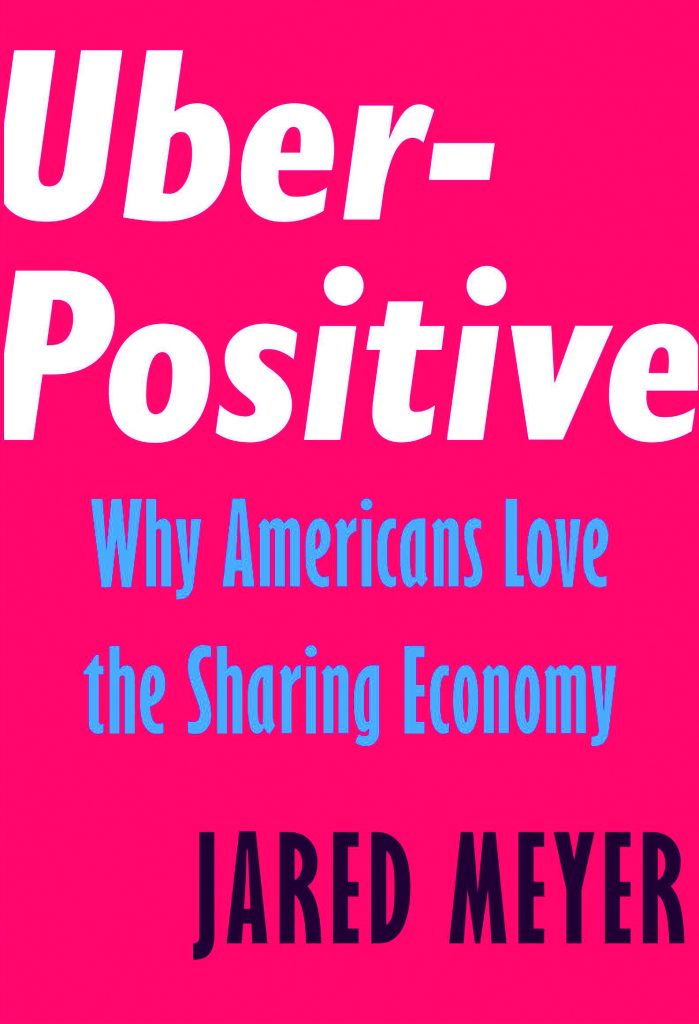By Jared Meyer
The sharing economy clearly benefits workers and consumers. So why does opposition to innovative business models persist? The answer: entrenched interests continue to use government to suppress competition.
Despite the economy’s slow recovery, entire industries are transforming to allow consumers a greater say in what they buy and workers greater flexibility in their schedules. These improvements in everyday life come directly from the rise of the sharing economy.
While much has been written about the novel business models of the sharing economy and the opportunities they create, the idea behind the sharing economy is nothing new. What sets these innovative companies apart from those of the past is their ability to use the Internet and smart phones to easily connect those who want something with those who have something to offer. The sharing economy offers easy access to an online platform that facilitates transactions between buyers and providers of goods or services.
Peer-to-peer online interaction, made available only recently by technological advances, is behind everything from eBay and Airbnb, to Zipcar and EatWith, to TaskRabbit and Uber. There have always been people who want to buy a hard-to-find product, find a place to stay, eat a home-cooked meal, get assistance on a task, or find a way to get around. The problem in the past was finding someone who was willing to offer the desired goods or services at a reasonable price.
Imagine what it would have been like if people went from door to door and asked home owners if they had an extra room to rent and for how much. Now, travellers simply have to log on to Airbnb, and, with a few clicks of a mouse, they can find a room that fits their needs and budgets.
Across all sectors of the economy, technology that makes exchanges easier and cheaper creates entrepreneurial opportunities for anyone with productive resources. These resources can be anything from physical or mental ability (such as handyman services, academic tutoring, and legal advice) to use of property (be it a drill, car, or office space). In other words, the real driving force behind the sharing economy is not smartphone apps, but lower transaction costs. And lower transaction costs affect every aspect of the economy and workers of all skill levels.
Before this technology existed, the difficulty of matching buyers with sellers led to the rise of many types of industries, such as the taxi dispatcher and travel agency, that built their business models around the lack of consumer empowerment. Now, with the sharing economy’s rapid expansion, these industries are facing increased competition. Rather than compete and adapt to the changing economy, some businesses work to stifle innovation through the political process.
Policymakers often fail to realise that a twenty-first century economy cannot flourish while it is under the thumb of outdated laws and regulations. Economies grow through a dynamic process that necessitates change and disruption. Forcing new business models to comply with rules that were written decades ago is no way to promote entrepreneurship.
Groundbreaking business models are in danger of being suppressed because of overzealous government regulation that protects existing businesses – all behind the façade of consumer protection. The question to ask with each new regulation is: who is actually being protected – the public or special interests?
By looking at ridesharing companies such as Uber and Lyft, we can see how the sharing economy is benefitting both workers and consumers.
How the Sharing Economy Helps Consumers
The main justification behind local, state, and federal regulation is consumer protection. A few decades ago, before ubiquitous Internet access, this reasoning may have made some sense.But in today’s economy, information is controlled by customers thanks to the web’s user-generated content.1
This means that regulators do not have to play as large of a role in protecting consumers. As the power dynamic continues to shift in favour of the customers, the need for an expansive regulatory framework further diminishes. The sharing economy is the natural extension of this consumer-friendly environment, with its embrace of robust feedback systems.
Along with many other sharing-economy companies, Uber and Lyft use post-service, dual-feedback systems where riders and drivers both leave reviews. This process reinforces positive behaviour and weeds out those who make trips difficult or unenjoyable. Customers learn that they can trust these reviews, and feedback allows companies to cut ties with those drivers who consistently receive negative criticism and reimburse customers who had bad experiences.
In contrast to the trust that the sharing economy relies on, driving a taxi is dangerous because its business model is conducive to crime and violence. For one, taxi trips are anonymous. Drivers also carry cash. For example, the average cash fare for New York City taxi trips in 2014 was around $12. With a typical driver shift of 9.5 hours and around 45 percent of trips paid for in cash, it is safe to assume that, on average, taxi drivers are carrying at least $100 in cash, which makes them attractive targets for robberies.2 This is one reason why the homicide rate for taxi drivers is twenty times higher than the US civilian average and more than double the rate for police officers.3
These dangers are corrected with ridesharing.4 The identities of passengers and drivers are both verified and safety is reinforced through the feedback system. Ridesharing companies also track both parties’ locations throughout the trip. Additionally, no cash ever changes hands, since all payments are taken care of electronically.
The safety benefits of convenient, affordable transportation options can also be seen in ridesharing’s effect on drunk driving. A January 2015 report issued by Uber and Mothers against Drunk Driving (MADD) shows that ride sharing saves lives because people use the service as a designated driver instead of trying to drive themselves home after they have had too much to drink. As the report states, in what is an obvious conclusion, “When people have more options, they make better, safer choices.”5
Furthermore, advances in technology allow companies to match supply and demand through advertising instantaneous pricing changes. These price changes are clearly communicated to riders before they request a ride. When demand for rides increases, companies can raise the fares that they pay to their drivers to get more cars on the road. On days when many people are looking for rides, such as Halloween and New Year’s Eve, it is common for Lyft rides to cost three times more than the normal fare, and rates can move even higher for Uber. This dynamic system, called “surge pricing” by Uber and “prime time” by Lyft, encourages more drivers to get out on the road during times of high demand.
This policy not only benefits drivers; it also benefits customers. Because of dynamic pricing, people can usually get an Uber or Lyft within a few minutes, even in times of high demand. It is simple economics.
Opponents of dynamic pricing claim that it discriminates against those with low incomes and only benefits those with high incomes. But this is not a class issue – having the option to get somewhere by paying more is always better than being stranded.
The increasing ubiquitousness of smart phones and credit cards, both required to use most ridesharing platforms, has allowed the customer base of Uber and its competitors to grow beyond its tech-savvy early adopters. Ridesharing’s benefits, similar to those of nearly all innovations, have now reached a wide segment of the population, including low-income households. For example, as Uber’s popularity in New York City grew over 2015, my analysis of the company’s ride data shows that the fastest growth was seen in low-income neighbourhoods that were chronically underserved by existing transportation options.6
How the Sharing Economy Helps Workers
The benefits of ridesharing’s growth do not end with riders. The companies could not have achieved their growth across the globe without strong participation from their driver partners.
The growing sharing economy that Uber epitomises creates many opportunities for workers. Since advances in technology greatly reduce transaction costs, those with goods or services to provide can increasingly become their own bosses without a great amount of overhead. People are taking advantage of this additional way to make extra money, with 50% of drivers who partner with Uber working less than ten hours a week and two-thirds having a separate full-time job. Uber is the main source of income for only 32% of drivers.7
Most people who partner with ridesharing companies do so because of the freedom offered by the platforms. About 75% of Uber drivers say that it has made their lives better by giving them greater control over their schedules.8 Part-time work is an important option to have available for many people – especially when workers have the ability to work full time in that same position. It is also a plus for consumers. Costs are lower if drivers spend more time with occupied back seats than if they are driving around looking for passengers.
While the sharing economy still accounts for a small percentage of overall US employment, the individualised, independent work arrangements that it embraces make up a much larger, and growing, percentage of the labour force.8
The economy is changing, and millennials’ attitudes about work and their careers are changing with it. The sharing economy’s rapid rise embodies many young workers’ new economic ideal – one driven by technology, convenience, and flexibility.10
Millennials have been called the most entrepreneurial generation. A Bentley University survey of millennials finds that two-thirds of respondents have a desire to start their own business,11 and Deloitte finds that about seven in ten millennials envision working independently at some point in their careers.12 The greater access enabled by the sharing economy can help young people fulfil their entrepreneurial dreams.
But rather than embrace young workers’ changing attitudes toward entrepreneurship, many politicians call for a return to the manufacturing “golden age” of the 1950s – and the high unionisation rates and lack of workplace flexibility that accompanied it.13
How to Embrace Innovation
Uber’s business model is to start operating first and work with regulators later. This embrace of permissionless innovation flies in the face of the antiquated command-and-control model of regulation. But it should not be the norm for businesses to have to ask for government permission to innovate. While innovators tirelessly work to drive the economy forward, regulators now function as annoying backseat drivers or roadblocks.
Rather than applying outdated regulations on ridesharing in the form of limits on its growth or business model, policymakers need to allow taxi companies to update their own business model. In other words, these companies need to become more like Uber – not the other way around.
By the time policymakers catch up to ridesharing, a new innovation will most likely already be gaining popularity. A regulatory framework for the future must embrace flexibility if it is to allow for the next transformational product or service to reach the market. One way to do this is to conduct regulation by specifying explicit ends (in terms of consumer safety) but leaving the means to reach those benchmarks open to innovation. Regulations specifying rigid means that only work for current business models will be outdated in a few years, when the next new technology arises. In short, regulators, who are still attempting to respond to the creation of the Internet, will never catch up to entrepreneurs.
Uber’s strategy of innovating around regulations might be compared with the effect that e-mail has had on the US Postal Service. USPS still has a monopoly on delivering letters – just as taxis still have a monopoly in many areas on street hails. But the technological advancement of e-mail and forward thinking by FedEx and UPS have rendered the postal service obsolete for companies and nothing more than the butt of jokes about government inefficiency.
New technology cannot simply be wished away. Rather, established firms need to face a choice: they can either embrace innovation or they can follow the taxi companies’ lead and dig in their heels as they are pulled toward irrelevance or bankruptcy.
Innovation arises through individuals taking risks – trial and error, success and failure. If people remain free to experiment and put their unique knowledge to use, the sharing economy will continue to grow. As new bills and regulations come across policymakers’ desks, they should look down at their smart phones, open their Uber apps, and remember that it is through permissionless innovation that the economy actually grows.
 “The war against the sharing or gig economy is the struggle of the dead hand of the past against a forward looking, flexible, consumer-driven future. It is a world war – a war of different possible worlds – being played out on a dozen fronts in many nations. Jared Meyer’s “Uber Positive” is an up front and personal view of the struggle in one iconic city: New York, where the forces of stasis are fat, happy and politically entrenched.”
“The war against the sharing or gig economy is the struggle of the dead hand of the past against a forward looking, flexible, consumer-driven future. It is a world war – a war of different possible worlds – being played out on a dozen fronts in many nations. Jared Meyer’s “Uber Positive” is an up front and personal view of the struggle in one iconic city: New York, where the forces of stasis are fat, happy and politically entrenched.”
– Grover Norquist, President of Americans for Tax Reform
About the Author
 Jared Meyer is a fellow at the Manhattan Institute for Policy Research and the author of Uber-Positive: Why Americans Love the Sharing Economy (Encounter Books, June 2016), from which this article is adapted. Follow him on Twitter @JaredMeyer10.
Jared Meyer is a fellow at the Manhattan Institute for Policy Research and the author of Uber-Positive: Why Americans Love the Sharing Economy (Encounter Books, June 2016), from which this article is adapted. Follow him on Twitter @JaredMeyer10.
References
1. https://www.amazon.com/Age-Customer-Prepare-Moment-Relevance/dp/0970927827
2. http://www.nyc.gov/html/tlc/downloads/pdf/2014_taxicab_fact_book.pdf
3. http://www.bls.gov/iif/oshwc/cfoi/cftb0278.pdf
4. http://www.cato.org/publications/policy-analysis/ridesharing-safe
5. https://2q72xc49mze8bkcog2f01nlh-wpengine.netdna-ssl.com/wp-content/uploads/2015/
01/UberMADD-Report.pdf
6. https://www.manhattan-institute.org/sites/default/files/ib_38.pdf
7. http://2q72xc49mze8bkcog2f01nlh.wpengine.netdna-cdn.com/wp-content/uploads/2015/
12/BSG_Uber-Driver-Roadmap-2.0_12.7.15_FIN2.pdf
8. https://s3.amazonaws.com/uber-static/comms/PDF/Uber_Driver-Partners_Hall_Kreuger_2015.pdf
9. http://mercatus.org/sites/default/files/Evaluating-Growth-1099_Dourado_MOP_v2.pdf and https://www.americanactionforum.org/research/independent-contractors-and-the-emerging-gig-economy/
10. http://economics21.org/sites/e21/files/HouseEducationWorkforceTestimony-1.pdf
11. http://www.bentley.edu/newsroom/latest-headlines/bloomberg-radio-broadcasts-two-live-shows-bentley-campus-featuring-latest
12. http://www2.deloitte.com/global/en/pages/about-deloitte/articles/millennialsurvey.html
13. http://reason.com/archives/2016/06/21/why-hillary-hates-uber

































































